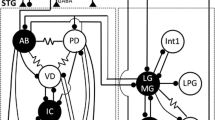Summary
-
1.
The generation of the pyloric motor pattern of the Stomatogastric ganglion of the crab,Cancer pagurus, was studied via intracellular recording in isolated ganglia. Synaptic interactions of the four pyloric dilators (PD), the single lateral pyloric (LP) and the eight pyloric (PY) neurons as well as aspects of their functional significance were investigated in some detail.
-
2.
The medium-sized m-PD-bursting pacemakers which constitute the trigger neurons for the pyloric discharge pattern are electrotonically coupled together and to the small sized s-PD-neurons which appear to assist in driving the m-PD-neurons. Slow membrane oscillations are less attenuated than spikes.
-
3.
The pyloric dilator (PD) neurons are mutual inhibitory with the lateral pyloric (LP)-neuron. The characteristic time-course of the inhibition onto the LP-neuron (fast rise, plateau phase) is brought about by the concomitant discharge of the m-PD-neurons. The LP onto PD feedback inhibition appears to stabilize or to help to maintain a bursting characteristic of the PD-neurons.
-
4.
The PD-neurons also inhibit the pyloric (PY)-neurons. Additionally, some of the inhibitory connections are in parallel with electrical coupling. The coactivation of chemical inhibitory and electrotonic synapses may participate in slowing the synaptic parameters (delay, rise and fall).
-
5.
Lateral pyloric (LP) and pyloric (PY) neurons are mutual inhibitory interconnected. The sequential discharge of these neurons in the pyloric pattern may be generated by the delayed discharge of the PY-neurons (see 4) and the inhibitory input from the LP-neuron which further delays the discharge of the PY-neurons.
-
6.
Some of the pyloric (PY) neurons are interconnected electrotonically.
-
7.
It is concluded that in addition to chemical inhibitory synaptic interconnections, electrotonic interactions contribute significantly to the production of the pyloric output pattern.
Similar content being viewed by others
Abbreviations
- PD :
-
Pyloric dilators
- LP :
-
(single) lateral pyloric neuron
- PY :
-
(8) pyloric neurons
- m-PD :
-
medium-sized pyloric dilator neurons
- s-PD :
-
small-sized pyloric dilator neuron
- IPSP :
-
inhibitory postsynaptic potential
References
Asada, J., Bennett, M.V.L.: Experimental alternation of coupling resistance of an electrotonic synapse. J. Cell Biol.49, 159–172 (1971)
Dando, M.R., Chanussot, B., Nagy, F.: Activation of command fibres to the stomatogastric ganglion by input from a gastric mill proprioceptor in the crabCancer pagurus. Mar. Behav. Physiol.2, 197–228 (1974)
Dando, M.R., Selverston, A.L.: Command fibres from the supraoesophageal to the stomatogastric ganglion inPanulirus argus. J. comp. Physiol.78, 138–175 (1972)
Gardner, D.: Interconnection of identified multiaction interneurons in buccal ganglia ofAplysia. J. Neurophysiol.40, 349–361 (1977)
Getting, P.A.: Modification of neuron properties by electrotonic synapses. I. Input resistance, time constant, and integration. J. Neurophysiol.37, 846–857 (1974)
Govind, C.K., Atwood, H.L., Maynard, D.M.: Innervation and neuromuscular physiology of intrinsic foregut muscles in the blue crab and spiny lobster. J. comp. Physiol.96, 185–204 (1975)
Hartline, D.K., Maynard, D.M.: Motor patterns in the stomatogastric ganglion of the lobsterPanulirus argus. J. Exp. Biol.62, 405–420 (1975)
Hermann, A.: Generation of a fixed motor pattern. II. Electrical properties and synaptic characteristics of pyloric neurons in the stomatogastric ganglion of the crab,Cancer pagurus. J. comp. Physiol.130, 229–239 (1979)
Hermann, A., Dando, M.R.: Mechanism of command fibre operation onto bursting pacemaker neurons in the stomatogastric ganglion of the crab,Cancer pagurus. J. comp. Physiol.114, 15–33 (1977)
King, D.G.: Organization of crustacean neuropil. I. Patterns of synaptic connections in lobster stomatogastric ganglion. J. Neurocytol.5, 207–237 (1976a)
King, D.G.: Organization of crustacean neuropil. II. Distribution of synaptic contacts on identified motor neurons in lobster stomatogastric ganglion. J. Neurocytol.5, 239–266 (1976b)
Marder, E.: Cholinergic motor neurones in the stomatogastric system of the lobster. J. Physiol.257, 63–68 (1976)
Maynard, D.M.: Integration in crustacean ganglia. In: Neurons and hormonal mechanisms of integration. Symp. Soc. Exp. Biol. 20, pp. 237–255. New York: Academic Press 1966
Maynard, D.M.: Simpler networks. Ann. N.Y. Acad. Sci.193, 59–72 (1972)
Maynard, D.M., Burke, W.: Electrotonic junctions and negative feedback in the stomatogastric ganglion of the mud crab,Scylla serrata. Am. Zool.6, 95 (1966)
Maynard, D.M., Dando, M.R.: The structure of the stomatogastric neuromuscular system inCalinectes sapidus, Homarus americanus andPanulirus argus. Phil. Trans. B268, 161–220 (1974)
Maynard, E.A.: Electron microscopy of stomatogastric ganglion in the lobster,Homarus americanus. Tissue and Cell3, 137–160 (1971)
Mulloney, B.: Organization of the stomatogastric ganglion of the spiny lobster. V. Coordination of the gastric and pyloric system. J. comp. Physiol.122, 227–240 (1977)
Pantin, C.F.A.: Notes on microscopical technique for zoologists. London: Cambridge University Press 1961
Russell, D.F.: Rhythmic excitatory inputs to the lobster stomatogastric ganglion. Brain Res.101, 582–588 (1976)
Selverston, A.L.: The use of intracellular dye injections in the study of small neural networks. In: Intracellular staining in neurobiology. Kater, S.B., Nicholson, C. (eds.), pp. 255–280. Berlin, Heidelberg, New York: Springer 1973
Selverston, A.L., Russell, D.F., Miller, J.P., King, D.G.: The stomatogastric nervous system: structure and function of a small neural network. Progr. Neurobiol.7, 215–290 (1976)
Wachtel, H., Kandel, E.R.: Conversion of synaptic excitation to inhibition at a dual chemical synapse. J. Neurophysiol.34, 56–68 (1971)
Warshaw, H.S., Hartline, D.K.: Simulation of network activity in stomatogastric ganglion of the spiny lobster,Panulirus. Brain Res.110, 259–272 (1976)
Wine, J.J., Mistick, D.C.: Temporal organization of crayfish escape behavior: delayed recruitment of peripheral inhibition. J. Neurophysiol.40, 904–925 (1977)
Author information
Authors and Affiliations
Rights and permissions
About this article
Cite this article
Hermann, A. Generation of a fixed motor pattern. J. Comp. Physiol. 130, 221–228 (1979). https://doi.org/10.1007/BF00614608
Accepted:
Issue Date:
DOI: https://doi.org/10.1007/BF00614608



